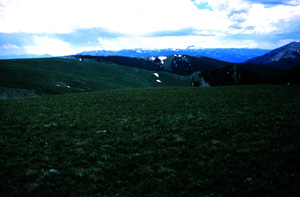Community Field Guide
Scientific Name:
Carex rupestris - Potentilla ovina Herbaceous Vegetation
Common Name:
Curly sedge - sheep cinquefoil Herbaceous Vegetation
Community Description
Summary:
This association has been reported from only southwestern Montana on the Beaverhead, Madison, East Pioneer and Tendoy mountain ranges. Occurring mostly as small to infrequently large patches, this vegetation is strictly an alpine community (documented elevation range from 2900-3170 m (9500-10,400 feet)). Stands occupy the most exposed and wind-swept upper slopes, saddles and ridgetops, and sites are most probably blown snow-free in winter. This association has been found only on calcareous parent materials. Wind deflation often results in a gravelly pavement with sites having an average of more than 65% exposed substrate. Structurally, this association is predominantly an alpine cushion plant community that can grade to alpine turf community on more protected sites. Graminoid cover averages 11%; species with 50% or greater constancy include Carex rupestris, Carex obtusata, Carex elynoides, Leucopoa kingii (= Festuca kingii), Festuca brachyphylla, and Elymus scribneri (= Agropyron scribneri). Only the first two graminoid species noted are diagnostic for the type. Cushion plants form the dominant aspect for this community (29% canopy cover); primary among which are Phlox pulvinata, Potentilla ovina, Minuartia obtusiloba (= Arenaria obtusiloba), Oxytropis campestris, Erigeron compositus, and Eritrichium nanum (only the first two species noted have been recognized as diagnostic for the type). A very stunted form of Dasiphora fruticosa ssp. floribunda (= Pentaphylloides floribunda) was the only shrub, sporadically noted. Lichen and mosses constitute less than 2% canopy cover on average. This type is usually noted to grade to a dry turf type Carex elynoides Herbaceous Vegetation (CEGL001852) or Carex scirpoidea - Potentilla diversifolia Herbaceous Vegetation (CEGL001867), a moist turf association, both of which occur on relatively more protected sites, ostensibly having a more favorable moisture regime.
Environment:
Carex rupestris / Potentilla ovina is transitional between an alpine turf and a cushion plant type. It occurs on exposed, windswept upper slopes, saddles and ridgetops, apparently strongly associated with soils developed from calcareous parent materials found in the Beaverhead, Madison, Pioneer, Tendoy and Blacktail Ranges. Appropriate habitat occurs in other ranges of southwestern Montana, especially the Centennial Range. It was sampled at elevations ranging from 9,300 to 10,400 feet. In several of the ranges, Carex rupestris / Potentilla ovina generally graded into the Carex elynoides or Carex scirpoidea / Potentilla diversifolia turf communities of deeper soils on more protected slopes, whereas in the Blacktail and Tendoy Ranges it graded to Festuca idahoensis dominated community types, particularly Festuca idahoensis - Elymus trachycaulus. It grades to fellfield or cushion plant communities that typify harsher, more windswept sites.
Vegetation:
Mean graminoid cover was 11%. Important graminoids were Carex rupestris, Calamagrostis purpurascens, and Poa secunda, and at higher elevations Festuca ovina, and Festuca kingii. Carex elynoides was common in some stands. Mean forb cover was 29%. Consistently present and often well-represented forbs include Potentilla ovina, Minuartia obtusiloba, Oxytropis campestris and Phlox pulvinata. Occurring consistently but with low cover is Eritrichium nanum, Bupleurum americanum, Cymopterus bipinnatus, Erigeron compositus and Senecio canus. Trifolium haydenii, Selaginella densa and Silene acaulis were well represented in some stands. The shrub, Dasiphora fruticosa ssp. floribunda, was present in one stand. Lichen and moss canopy cover averaged less than 2%.
Global Rank: G4 State Rank: S4
Global Rank Comments:
This community is not under immediate threat, but it could be altered (favoring graminoids) by intensive sheep grazing. Mining and recreation are the only other potential threats and are of a very small-scale nature. All sampled Montana occurrences are relatively inaccessible and at least one occurrence is within a Forest Service Research Natural Area. Given that environmental parameters for this type are common and broadly distributed and that virtually all important constituent species show a broad regional distribution, this association can be expected to be common in the ranges of southwestern Montana and along this state's portion of the Rocky Mountain Front, as well as in east-central Idaho. Though not formally crosswalked or examined in depth, communities at least superficially similar have been described for Idaho, Colorado and New Mexico thus increasing the possibility that this is a very broadly distributed type as well.
Community References
Identifier:
CEGL001862
Author:
97/10 / S. V. Cooper et al.
Citations:
Baker 1983a, Bourgeron and Engelking 1994, Cooper and Lesica 1992, Cooper et al. 1997, Driscoll et al. 1984, Moseley 1985, Urbanczyk and Henderson 1994, Willard 1979
View Detailed Citation Information | New Community Search | NatureServe Explorer Community Information
This information is from the:
Montana Natural Heritage Program
Montana State Library--Natural Resource Information System
1515 East Sixth Ave., Helena, MT 59620-1800
406 444-3989
mtnhp.org
mtnhp@mt.gov






